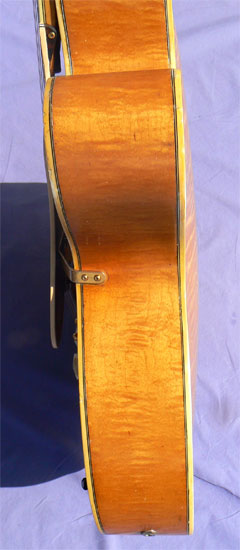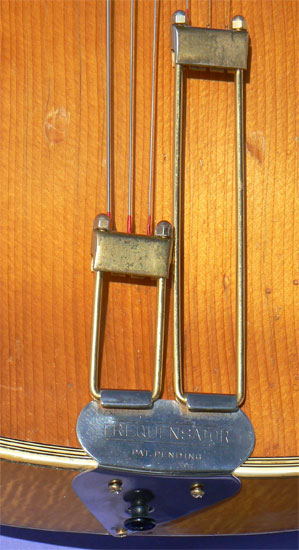Home / Instruments
/Accessories / Ordering / Tips
archtop.com
1950 Epiphone Zephyr Deluxe Regent, Unique 18" Body
Status: Pricing and hold status for all instruments currently available
is shown on our Instruments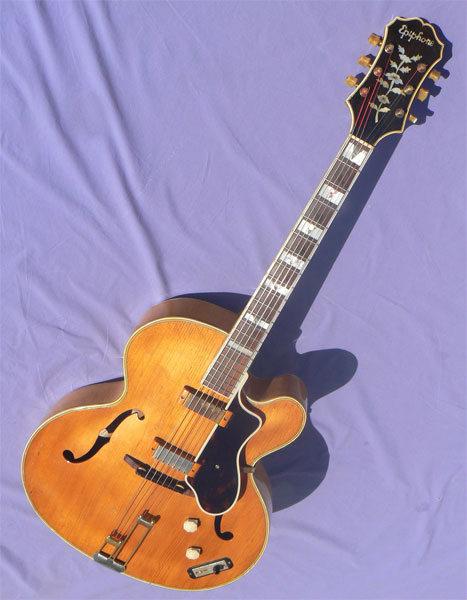 page here. If this instrument
does not appear on the Instruments page
it has been sold, and is no longer available. Photos and descriptions of
Previously Sold instruments may be found here. To be notified of examples of this
model or similar instruments in the future, please contact [email protected],. Please be specific
on which instrument(s) you're looking for, and we'll be happy to contact
you as soon as they become available.
page here. If this instrument
does not appear on the Instruments page
it has been sold, and is no longer available. Photos and descriptions of
Previously Sold instruments may be found here. To be notified of examples of this
model or similar instruments in the future, please contact [email protected],. Please be specific
on which instrument(s) you're looking for, and we'll be happy to contact
you as soon as they become available.
Serial #: 60757, blue NY label
Body size at lower bout: 18 1/2" Scale length: 25
1/2" Nut width: 1 11/16" Neck depth, 1st/10th frets: .83/.98
Materials: Highly figured arched tiger flame maple back and sided; arched spruce top; solid 7 piece tiger maple neck; 7-ply body binding; 5 ply fingerboard binding; triple-bound head and heel cap; solid Brazilian rosewood fingerboard with mother of pearl split-block inlay; ornate pearl tree-of-life peghead inlay.
Hardware: Original gold hardware includes twin 'New York' Tone Spectrum adjustable single coil pickups; Pat. Pend. Frequensator tailpiece; epsilon-logo 16X1 tuners; hex-key truss rod; adjustable Brazilian rosewood bridge; carousel master volume and tone knobs. Vintage correct triple-bound dark tortoise pickguard.
Notes: Just when you think you've seen them all...
Epiphone's Deluxe model was introduced in 1931 as the flagship of their archtop line. A decade later in 1941, the Zephyr Deluxe model made its debut, as the top of Epi's new electric offerings. By 1948, a cutaway version was introduced, dubbed the Zephyr Deluxe Regent, and fitted with the 'New York' single coil pickups by 1950.
That same year, Epiphone made a curious move. Their acoustic Deluxe model, a perennially competitor to Gibson's L-5, was suddenly upsized from 17 1/2 to 18 1/2 inches, the same size as its top-line Emperor. As the two models were now virtually identical, with only a $50 price difference, the Super Jumbo Deluxe was quickly retired the following year, becoming one of the firm's rarest offerings.
The popular electric Zephyr Deluxe Regent however, maintained its standard 17+ inch body. Or so we thought, until this striking guitar came over the transom. Sometime in 1950, this electric Deluxe was built, apparently on the form for an Emperor body. Whether it was a custom order, or simply a one-off experiment, only history will know: it's the only 18" ZDR listed in the authoritative New York Epiphone Registry. In any event, this unique instrument would appear to be the direct progenitor of Epi's first electric Emperor model, the Zephyr Emperor Vari-Tone (later Regent), which would not be issued until the following year, in 1951.
With it's split block inlays, tree-of-life peghead inlay, and extravagant tiger flame maple body, this oversize Zephyr Deluxe Regent differed from the Emperor electric in only minor cosmetics, principally the amount and placement of the binding. The most significant variation between the two super jumbo models was in the electronics: while this Deluxe is equipped with twin pickups, the Zephyr Emperor added a third to the middle position.
Why is this important to the player? Epiphone in its exuberance fitted the Zephyr Emperor with an extravagant six pole pushbutton pickup selector, no doubt to one-up Gibson's three pickup, four knob, ES-5 model. But what looked good in the catalog fared less well on the gig however, as the Emperor's push buttons were found to produce an audible clunk though the amp. Happily though, this super jumbo Deluxe has no such drawback, as its adjustable single coil pickups are switched silently with a conventional three position blade selector. No clunk...who'da thunk?
Maintained in fine original condition, this rarity shows spectacular tiger flame maple figure in the back, sides and neck, with an arched soundboard whose grain and color are strongly suggestive of Adirondack spruce. With its all-original finish, gold hardware and electronics, the guitar is fitted with a handsome recent bound tortoise pickguard from an original template in our shop. The lustrous deep blonde lacquer has ambered to a warm honey color, with moderate weathering typical of some seven decades of age.
Notably free of pick, buckle, thumb or fingerboard wear, the body shows some scattered checking and playwear, mostly confined to some finish nicks on the lower bout. The original hand wound 'Tone Spectrum' pickups have the fidelity and detail for which their unpotted single coil design is renowned, and the laminate construction of the body enhances both sustain and feedback resistance as well: pure bop era heaven.
The gentle C profile neck is laminated with an extravagant seven plies of maple and walnut, with a hex key truss rod at the fingerboard extension. Action is smooth and low, with a fresh high precision setup over a handsome Brazilian rosewood fingerboard, inlaid with contrasting abalone and pearl. All binding is original and tight to the body, and the Pat. Pend. Frequensator tailpiece is solid at the bend.
An instrument of exceptional rarity, performance, and appeal, this historic guitar is a most remarkable find for both player and collector alike. Simply o ne of a kind: call now.
Setup: Trussrod tension and neck relief adjusted; bridge height adjusted; bridge compensation set; string slots at nut and bridge inspected and recut as necessary; bridge foot contour inspected and fit to top as necessary; bridge radius inspected and recurved as necessary; bridge wheels and tuners lubricated; fingerboard and bridge oiled; body and neck cleaned and hand polished. Action is 4/64 to 5/64" at the 12th fret, with medium gauge .013 phosphor bronze strings.
Case: Brown vintage Lifton deluxe arched plush lined hardshell case.
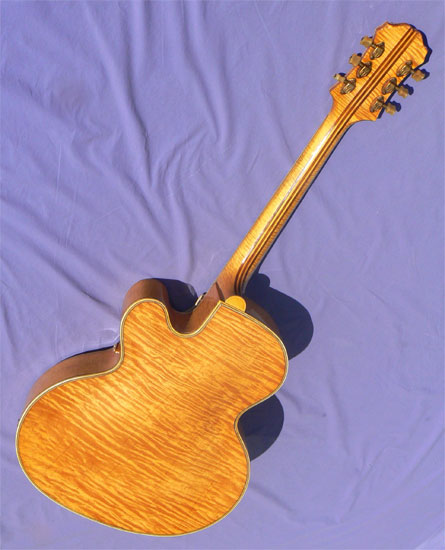
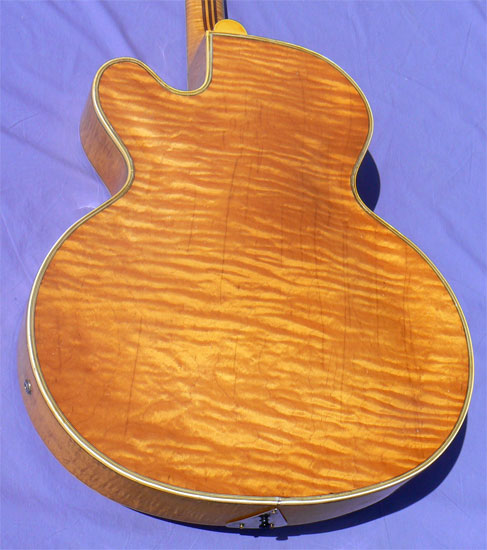
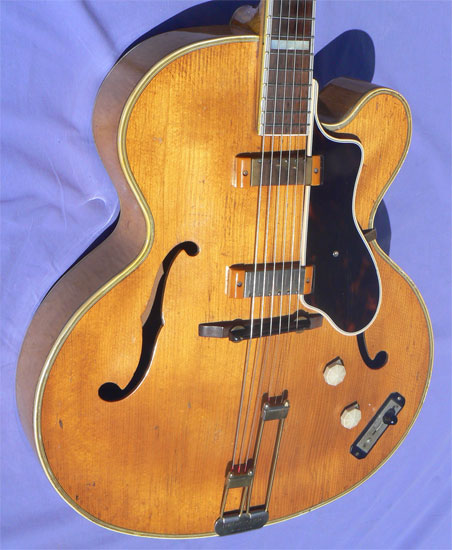
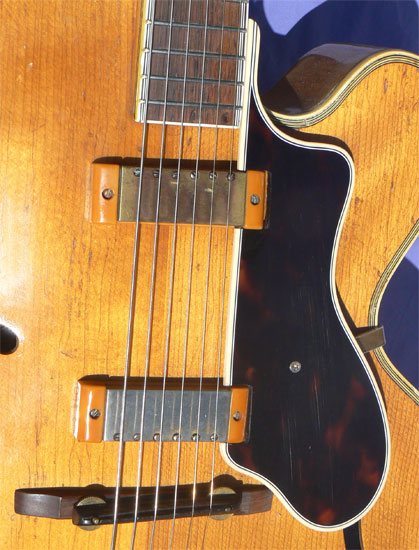
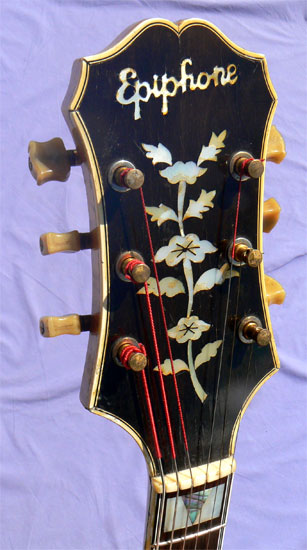

 page here. If this instrument
does not appear on the Instruments page
it has been sold, and is no longer available. Photos and descriptions of
Previously Sold instruments may be found here. To be notified of examples of this
model or similar instruments in the future, please contact [email protected],. Please be specific
on which instrument(s) you're looking for, and we'll be happy to contact
you as soon as they become available.
page here. If this instrument
does not appear on the Instruments page
it has been sold, and is no longer available. Photos and descriptions of
Previously Sold instruments may be found here. To be notified of examples of this
model or similar instruments in the future, please contact [email protected],. Please be specific
on which instrument(s) you're looking for, and we'll be happy to contact
you as soon as they become available.






